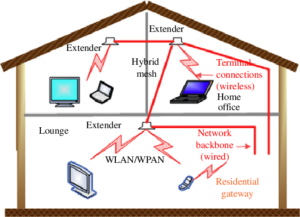Overview
Optical Wireless Home Networks (OWHN), more commonly known as indoor FSO networks, is a wireless broadband communication within homes and office buildings. This technology relies on the use of infrared and visible light to transmit data as well as illuminate the space simultaneously. OWHN must be connected to a network backbone that allows individual light sources to propagate the signal. These light sources use two distinct modes of propagation: Line-Of- Sight (LOS) links and diffused links.[1]
LOS links require a direct path between the sender and receiver. Meanwhile, diffused links are more practical for the common home or office buildings since they use multiple path propagation, which is the reflection of light from the various objects within the room. However, there is a trade-off between transmission rates and object interference, as diffused links have lower data rates when compared to LOS links.[2]
The image below demonstrates a standard setup for an OWHN. Each extender is both a source of light as well as a data sender, using a diffused link. Each room has its own extender to prevent interference and each extender is connected to a central backbone (Dede et al. Evaluation of Optical Wireless Technologies in Home Networking: An Analytical Hierarchy Process Approach).
Related Links
Article: Evaluation of Optical Wireless Technologies in Home Networks
Article: Home access networks using optical wireless transmission

